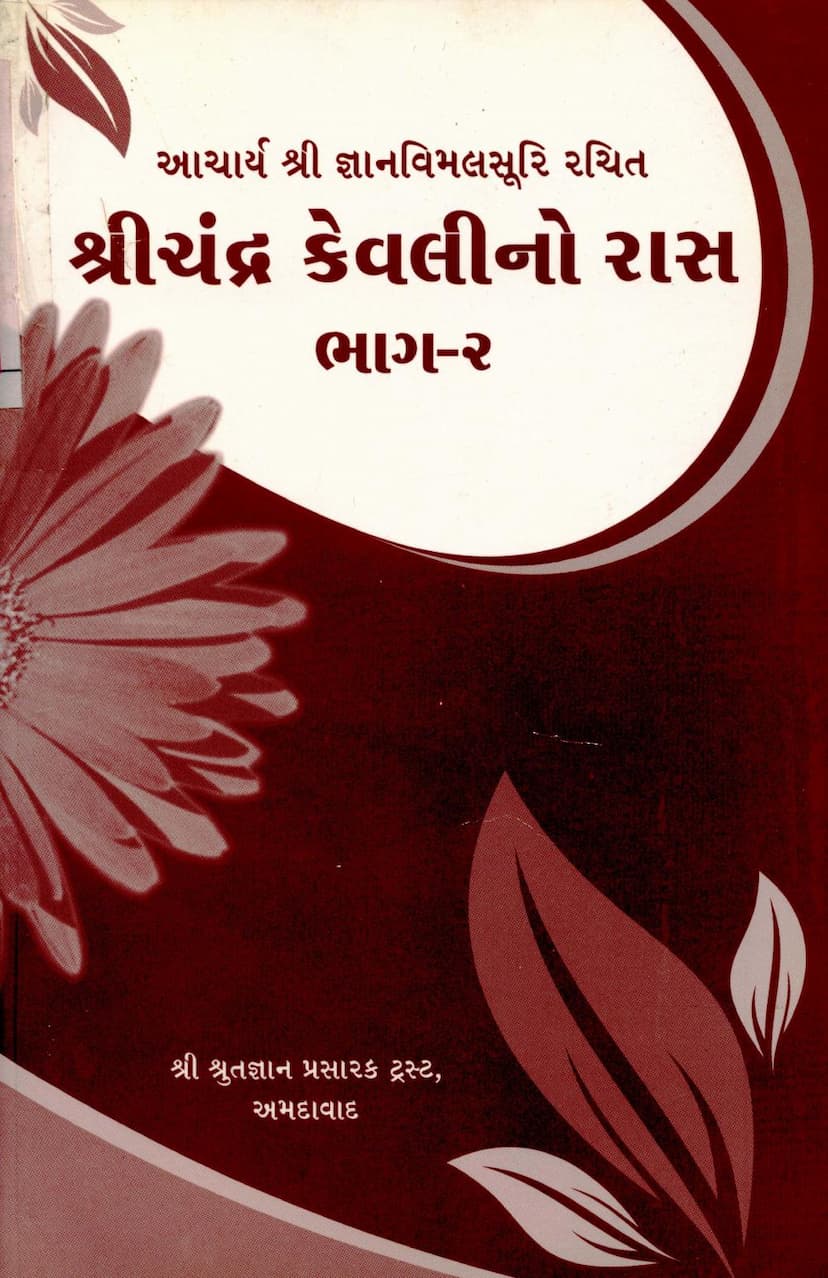Shreechandra Kevalino Ras Part 02
Added to library: September 2, 2025

Summary
This document is the second part of "Shreechandra Kevalino Ras," a Jain text authored by Acharya Gyanvimalsuri. Published by Shree Shrutgyan Prasarak Trust in Ahmedabad, this volume continues the narrative of Shreechandra, a revered figure in Jainism. The text is organized into several chapters ("Adhikaras") and songs ("Dhal").
Here's a summary of the content, based on the provided pages:
Overall Theme: The text details the life, spiritual journey, and teachings of Shreechandra Kevali (also known as Shreechandra Kevalin). It follows his path of righteousness, his interactions with various individuals, his overcoming of obstacles, and his eventual attainment of liberation (Keval Gyan/Moksha). The narrative emphasizes Jain principles like non-violence (Ahimsa), adherence to vows, ethical conduct, and the importance of spiritual knowledge and practices.
Key Content Highlights:
- Spiritual and Ethical Teachings: The "Ras" (a type of devotional song or narrative poem) elaborates on Jain philosophy, including the concepts of Karma, Dharma, Ahimsa, control of senses, and the ultimate goal of Moksha. It uses allegorical stories and teachings to illustrate these points.
- Narrative Structure: The story unfolds through a series of poetic verses and songs, often set to specific musical meters and tunes (indicated by "Dhal" and "Raag"). These songs describe Shreechandra's actions, his internal thoughts, and the events of his life.
- Encounters and Trials: Shreechandra faces numerous challenges and encounters various characters, including kings, ascetics, common people, and even supernatural beings. He demonstrates wisdom, compassion, and unwavering faith in his spiritual path.
- Previous Lives and Karma: The text often refers to past lives and the consequences of actions (Karma). It highlights how deeds from previous births influence present circumstances and how spiritual practices can overcome negative karmic influences.
- Devotional Aspects: The "Ras" is a devotional work, intended to inspire faith and devotion towards Shreechandra and the Jain principles he embodies. The language is poetic and filled with praise for his virtues.
- Detailed Descriptions: The text provides vivid descriptions of places, events, and characters. For instance, it details the natural beauty of landscapes, the grandeur of royal courts, the austerity of ascetics, and the emotional states of individuals.
- Emphasis on Right Conduct: Specific passages focus on the importance of observing Jain practices correctly, such as the rules for monks and nuns, the significance of fasting (Anshan), and the proper way to approach spiritual knowledge and practices. It also touches upon forbidden actions and their consequences.
- Genealogical and Historical Context: The text mentions certain communities (e.g., Vagra community), historical figures, and places, providing some contextual background to the narrative.
- Specific Events:
- The Story of Lohkhuro: A significant portion of the text narrates the story of Lohkhuro, his past misdeeds, and his eventual transformation through the teachings of Shreechandra.
- The Merchant's Daughters and the Incarnations: The narrative delves into the past lives and karmic connections of characters, explaining how events in previous births influence present relationships and situations.
- Shreechandra's Renunciation and Spiritual Practices: The text describes Shreechandra's decision to renounce worldly pleasures and his rigorous spiritual practices.
- The King's Dilemma and the Muni's Wisdom: A recurring theme involves rulers seeking spiritual guidance and overcoming their worldly attachments and dilemmas through the wisdom of ascetics, particularly Shreechandra or his disciples.
- The Tale of Sunyasundari and the Parrot: The story of a parrot that is gifted to a princess, and the subsequent events, illustrates the concept of destiny and the influence of past karma.
- The Story of Susushili and the Brahmin's Family: This narrative highlights the consequences of karma, particularly negative actions stemming from desires and anger, and the path to redemption through devotion and right conduct.
- The Tale of Susundari and the Shravak: This section likely describes the spiritual progress of a lay follower, showcasing how devotion and adherence to principles can lead to a better rebirth.
- The Legend of Shreechandra's Royal Life and Renunciation: The text details his rise to kingship, his just rule, and ultimately his renunciation of the kingdom to pursue spiritual enlightenment.
- The Significance of Tapasya: The importance of austerities and self-discipline for spiritual purification and liberation is repeatedly emphasized.
- The Concept of Ahimsa: The text likely underscores the principle of non-violence in all aspects of life, as a fundamental Jain tenet.
- The Path to Keval Gyan: The narrative culminates in Shreechandra's attainment of Keval Gyan (omniscience) and his subsequent role as an exponent of the Jain path.
Publisher's Notes: The introductory notes mention previous publications of the "Ras" and explain that this edition is split into two parts due to the volume of content. They also acknowledge the efforts of individuals involved in compiling and refining the text, including Ashok Kumar Jain who arranged and corrected the verses. The publishers express their gratitude and hope for forgiveness from scholars for any errors.
Overall Tone: The text is devotional, didactic, and narrative, aiming to educate and inspire readers about the life and teachings of Shreechandra Kevali within the Jain tradition. It emphasizes the power of spiritual practice, good deeds, and unwavering faith in navigating the complexities of life and achieving ultimate liberation.